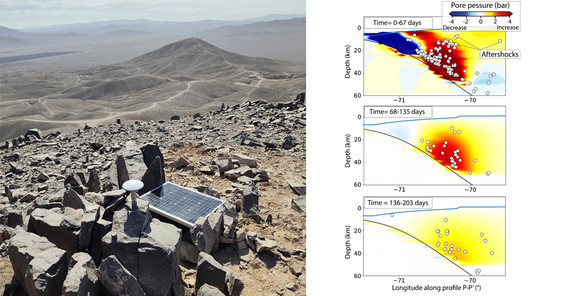After large earthquakes, the Earth's crust continues to deform for weeks to years. This slow postseismic motion, often detected by geodetic instruments such as Global Navigation Satellite Systems (GNSS), is usually accompanied by aftershocks that gradually decay over time. In subduction zones, aftershocks within the upper plate can be particularly hazardous, as they may occur at shallow depths beneath densely populated coastal regions. While scientists have long examined aftershocks through changes in static stress, the time-dependent nature of these sequences has remained poorly understood.
A new study led by researchers from the University of Potsdam and the GFZ Helmholtz Centre for Geosciences, in collaboration with international partners, identifies pore-pressure diffusion as a major process influencing the spatio-temporal characteristics of upper-plate aftershock sequences. Here, diffusion is the process by which pore-pressure changes caused by the main shock gradually spread through the permeable crust. The team used a multi-disciplinary approach that combines high-resolution seismic data, geodetic time series, and 4-D hydro-mechanical modeling of the 2014 magnitude 8.2 Iquique earthquake in northern Chile. This enabled them to show that stress changes related to evolving pore pressure following the main earthquake can best explain both the spatial distribution and the temporal decay of upper-plate aftershocks.
“Understanding the physical mechanisms behind aftershock sequences is crucial for assessing seismic hazard in the aftermath of major earthquakes, when already damaged infrastructure remains vulnerable,” says Dr. Carlos Peña, lead author and geophysicist at the University of Potsdam. “Our results also indicate that pore-pressure changes can trigger aftershocks on all fault types, including those that are not optimally oriented with respect to the prevailing stress field, contrary to previous assumptions.”
The study provides new insights into the role of fluid processes in the earthquake cycle and contributes to the development of improved physics-based models for aftershock forecasting. This knowledge may help refine scenario simulations in regions where large subduction earthquakes are expected, supporting future disaster risk management and resilience planning.
The research will continue within the framework of the DFG-funded project STRONG (Eigene Stelle), in which Dr. Peña will now incorporate satellite-based InSAR observations and high-performance computing to process and analyze large-scale geodetic datasets. Under the supervision of Prof. Bodo Bookhagen, group leader of Geological Remote Sensing, this ongoing work aims to further investigate the role of crustal-scale pore-pressure processes and their relationship to surface deformation and seismicity in subduction zones.
Link to Publication: Peña, C., Heidbach, O., Metzger, S. et al. Pore-pressure diffusion controls upper-plate aftershocks of the 2014 Iquique earthquake. Nat Commun16, 9474 (2025). https://doi.org/10.1038/s41467-025-65013-6

